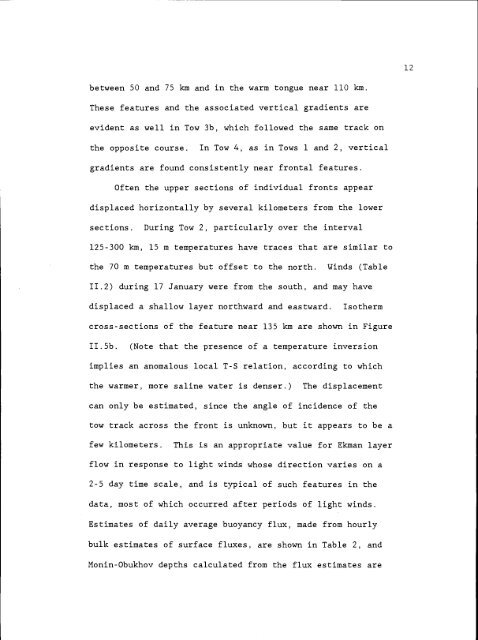Observations and Modelling of Fronts and Frontogenesis
Observations and Modelling of Fronts and Frontogenesis
Observations and Modelling of Fronts and Frontogenesis
Create successful ePaper yourself
Turn your PDF publications into a flip-book with our unique Google optimized e-Paper software.
etween 50 <strong>and</strong> 75 km <strong>and</strong> in the warm tongue near 110 km.<br />
These features <strong>and</strong> the associated vertical gradients are<br />
evident as well in Tow 3b, which followed the same track on<br />
the opposite course. In Tow 4, as in Tows 1 <strong>and</strong> 2, vertical<br />
gradients are found consistently near frontal features.<br />
Often the upper sections <strong>of</strong> individual fronts appear<br />
displaced horizontally by several kilometers from the lower<br />
sections. During Tow 2, particularly over the interval<br />
125-300 km, 15 m temperatures have traces that are similar to<br />
the 70 in temperatures but <strong>of</strong>fset to the north. Winds (Table<br />
11.2) during 17 January were from the south, <strong>and</strong> may have<br />
displaced a shallow layer northward <strong>and</strong> eastward. Isotherm<br />
cross-sections <strong>of</strong> the feature near 135 kin are shown in Figure<br />
II.5b. (Note that the presence <strong>of</strong> a temperature inversion<br />
implies an anomalous local T-S relation, according to which<br />
the warmer, more saline water is denser.) The displacement<br />
can only be estimated, since the angle <strong>of</strong> incidence <strong>of</strong> the<br />
tow track across the front is unknown, but it appears to be a<br />
few kilometers. This is an appropriate value for Ekman layer<br />
flow in response to light winds whose direction varies on a<br />
2-5 day time scale, <strong>and</strong> is typical <strong>of</strong> such features in the<br />
data, most <strong>of</strong> which occurred after periods <strong>of</strong> light winds.<br />
Estimates <strong>of</strong> daily average buoyancy flux, made from hourly<br />
bulk estimates <strong>of</strong> surface fluxes, are shown in Table 2, <strong>and</strong><br />
Monin-Obukhov depths calculated from the flux estimates are<br />
12















